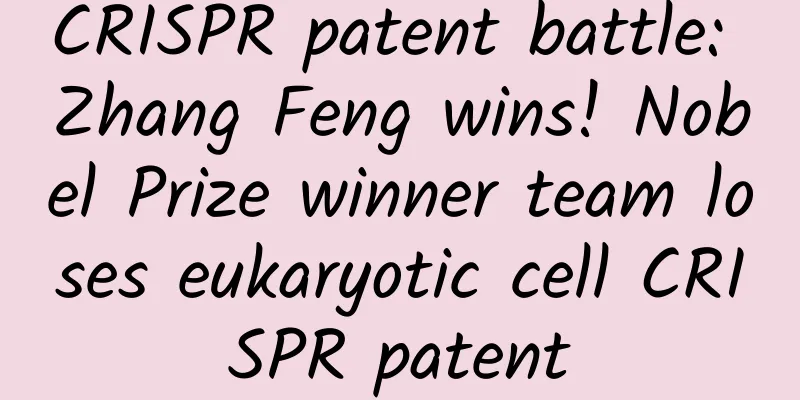CRISPR patent battle: Zhang Feng wins! Nobel Prize winner team loses eukaryotic cell CRISPR patent

|
The patent dispute over the 2020 Nobel Prize-winning CRISPR gene editing technology has made some progress, with the US Patent and Trademark Office ruling that the Broad Institute team, where Chinese scientist Feng Zhang is a member, has won the case. Details>>> New Media Editor/Li Yunfeng On February 28, 2022 local time, in the patent dispute surrounding CRISPR gene editing technology, the United States Patent and Trademark Office (USPTO) made a ruling in favor of Zhang Feng's Broad Institute team, ruling that the Broad Institute won the case. The Broad Institute where Zhang Feng works is a high-level genomics research center affiliated with the Massachusetts Institute of Technology and Harvard University. This result is equivalent to confirming that it was Zhang Feng's team that first invented CRISPR-Cas9 to edit human cells and use it to make drugs, rather than the CVC team represented by Jennifer Doudna and Emmanuelle Charpentier, winners of the 2020 Nobel Prize in Chemistry. (Note: The University of California, the University of Vienna and Emmanuelle Charpentier are collectively referred to as "CVC") In just a few years since its birth in 2012, CRISPR gene editing technology has become the most dazzling and most watched technology in the field of life sciences in recent years, and has always been regarded as a strong contender for the Nobel Prize. However, since the birth of CRISPR technology, it has been accompanied by patent disputes. Winning a CRISPR patent not only means countless wealth, but may also bring the highest honor - the Nobel Prize. Therefore, the CRISPR patent war has been protracted. (Photo source: Biological World) Regarding this latest ruling, James Mullen, CEO of Editas Medicine, a gene editing company founded by Zhang Feng, said that both the Broad Institute team and the CVC team have made important contributions to the application of gene editing in science. But this ruling by the Patent and Trademark Office "reaffirms the strength of our basic intellectual property rights." According to this ruling, Editas Medicine can obtain gene editing patents covering CRISPR-Cas9 and CRISPR-Cas12a in all human cells in the United States. Influenced by this good news, the stock price of Editas Medicine also rose by more than 10%. This latest ruling does not mean that the patent war between the two parties has come to an end. Jennifer Doudna of the CVC team said that this ruling is contrary to the decisions of more than 30 countries and the Nobel Prize Committee, and will continue to appeal to the US Federal Circuit Court of Appeals. But this ruling ends the CVC team's interference in the patents of the Broad Institute team in the United States. Similarly, it should be pointed out that this ruling means that companies operating in the United States that are related to CRISPR gene editing and have previously only obtained patent licenses from the CVC team, including the CVC team’s own Intellia Therapeutics, CRISPR Therapeutics, etc., will have to conduct patent negotiations with the Broad Institute team. STAT, a well-known American medical and health media, reported on it with the title: "University of California, Berkeley loses CRISPR patent case, ruling that gene editing company's patent rights to develop human therapies are invalid." (Image source: Biopharmaceutical Cloud) The research found that on August 17, 2012, Jennifer Doudna and Emmanuelle Charpentier collaborated to publish a milestone paper in the history of gene editing in Science, successfully analyzing the working principle of CRISPR-Cas9 gene editing. On February 15, 2013, Zhang Feng published a paper in Science, which for the first time improved and applied CRISPR-Cas9 gene editing technology to mammalian and human cells. (Image source: Biopharmaceutical Cloud) Since then, the CVC team represented by Jennifer Doudna and Emmanuelle Charpentier and the Broad Institute team represented by Zhang Feng have started a battle for the ownership of the CRISPR patent. The CVC team's initial paper did not mention that CRISPR gene editing can be used in eukaryotic cells, which are the key to developing human drugs. In 2014, the US Patent and Trademark Office awarded the key CRISPR patent for eukaryotic cells to the Broad Institute team. In 2016, the CVC team appealed to the US Federal Court, but was rejected. Since then, the CVC team has continued to appeal, and the Patent Trial and Appeal Board (PTAB) has intervened. The committee believes that the Broad Institute team was the first to prove that CRISPR is effective in eukaryotic cells, so it has patent priority. On February 4, 2022, the U.S. Patent and Trademark Office held a patent hearing, where two teams engaged in a seemingly endless debate over who invented the CRISPR genome editing tool that revolutionized biology. There were two core issues in this patent hearing. One was that the CVC team accused the Broad Institute team of obtaining early CRISPR information in an improper manner; the other was who invented the guide RNA (gRNA) that allows CRISPR to work in eukaryotic cells. The emergence of CRISPR gene editing has completely changed biology, making gene editing within reach, making genetic diseases no longer incurable, and bringing great hope to cancer treatment. Its great value in promoting science has been recognized by the Nobel Prize. In addition, in less than ten years since its birth, there are more than 10 listed companies around CRISPRA gene editing technology, and countless related startups. The huge economic returns brought by CRISPR have made the road of patents benefiting mankind exciting. Further reading: ◆◆◆ Why did gene editing win the Nobel Prize? This article was originally published in Beijing Science and Technology News on October 18, 2020 ▲Cover of Beijing Science and Technology News on October 18, 2020 The 2020 Nobel Prize in Chemistry went to two "scissor-handed" female scientists - Jennifer Doudna, professor at the University of California, Berkeley, and Emmanuelle Charpentier, professor at the Max Planck Institute for Infection Biology in Germany, in recognition of their revelations about the importance of CRISPR-Cas9, the natural immune system, to gene editing. There are so many scientists who have become famous for gene editing technology, why did these two female scientists win the Nobel Prize in Chemistry? ▲Jennifer Doudna (left) and Emmanuelle Charpentier (right) (Source: Nature) The long road to gene editing "I know a lot of outstanding scientists who never won this prize, and it has nothing to do with whether they are outstanding scientists," said Jennifer Doudna. Before receiving a congratulatory message from Nature magazine, the newly-crowned Nobel Prize winner didn't even know that she was the winner this year. It can be said that nowadays, whenever gene editing is discussed, the famous name "Jennifer Doudna" cannot be avoided. In 2012, Jennifer Doudna and Emmanuelle Charpentier teamed up to reveal to the world for the first time the magical power of CRISPR-Cas, the natural immune system. The discovery of this magical "gene scissors" really excited the entire scientific community at the time. In fact, the road of human exploration of gene editing is quite arduous and long. Targeted gene editing technology has developed rapidly due to the discovery of a variety of highly efficient targeted nucleases. Before the emergence of CRISPR-Cas gene editing, the three most common technologies were large-range nuclease technology, zinc finger nuclease technology (ZFN for short) and transcription activator-like effector nuclease technology (TALEN for short). In the early days of gene editing research, large-range nuclease technology was one of the most common technologies. However, this technology is not only limited by the types of natural large-range nucleases, but also difficult to adapt to the human genome, so its application is greatly limited. Subsequently, scientists discovered zinc finger proteins in 1984 and developed ZFN technology based on them. However, the emergence of this technology also brought another new problem: on the one hand, because the zinc finger sequence that recognizes specific DNA needs to be determined through library screening, the workload of the entire gene editing project is extremely huge, which is "time-consuming, labor-intensive and troublesome"; on the other hand, because the screening of zinc finger nucleases is very difficult, it is more likely to cause more and more complex off-target effects and induce cytotoxicity. In view of the above factors, gene editing technology in the ZFN technology era is still in the stage of "crossing the river by feeling the stones". In 1989, scientists successfully cloned an avrBs3 protein from a plant pathogen; 23 years later, scientists formally proposed the TALEN technology based on this, which gradually became the mainstream gene editing technology. Compared with the "predecessor" ZFN technology, TALEN technology has become simpler overall, and to a certain extent has improved the problem of ZFN technology being easy to off-target. It was also during the same period in the 1990s that scientists accidentally discovered that the Escherichia coli genome had highly homologous sequence repetitiveness, and these repetitive sequences were separated by regular sequences. As more and more similar repetitive sequences were discovered in other microorganisms, this repetitive sequence was officially named "CRISPR" in 2002, and scientists also discovered a series of conserved related genes (Cas) near it. It can be said that the emergence of CRISPR-Cas gene editing technology has completely changed the embarrassing situation that gene editing was both "expensive" and "costly". As one of the most groundbreaking emerging technologies in recent years, the highlight of CRISPR-Cas gene editing technology is that it only requires the use of the Cas9 enzyme - a guide RNA that can recognize the target DNA. In other words, scientists only need to "place an order" to buy a guide RNA, which can rewrite the genes of any organism, including human cells, with higher efficiency and accuracy. It costs less than $30 in hardware to "cut" genes, and use more affordable gene editing technology to upgrade agriculture and medicine, providing more possibilities for humans to treat more "incurable" genetic diseases. Discovering a "new pair of scissors" from scratch In 2012, Jennifer Doudna and Emmanuelle Charpentier jointly published a paper that theoretically explained the biological phenomena of the CRISPR-Cas system. They innovatively and pioneeringly unveiled the mystery of this "gene scissors" to the world, and provided a solid theoretical foundation for humans to perform "targeted" cutting and editing of genes. Their achievement was like a stone thrown into a calm lake, and soon triggered a series of new waves of research and development in the industry. In September 2012, a paper by Dr. Virginijus Siksnys, an academician of the Lithuanian Academy of Sciences, was published in the Proceedings of the National Academy of Sciences of the United States of America. He reconstructed the CRISPR system of Streptococcus thermophilus in Escherichia coli and confirmed that the system requires at least three components: Cas9 nuclease, crRNA and tracrRNA. In January 2013, Chinese-American scientist Feng Zhang of MIT and the Broad Institute and George Church, a professor of genetics at Harvard University, successively published papers in Science magazine, reporting the successful application of CRISPR-Cas gene editing technology in mice and human cells, and successfully implemented Jennifer and Emmanuelle's theoretical achievements in the gene editing of mammalian cells... With the joint efforts of many scientists, human gene editing technology has been rapidly elevated to a new level. Regarding this award, although many international journals including Nature believe that "Zhang Feng's absence from this Chemistry Award is unexpected", some voices, including Rao Yi, president of Capital Medical University and senior researcher at the Beijing Institute of Life Sciences, still believe that although Zhang Feng played an important role in the application and promotion of CRIPSR gene editing technology in human cells, the achievements made by Jennifer Doudna and Emmanuelle Charpentier in this field are more "pioneering" and "original". In fact, although the patent ownership of CRIPSR gene editing technology has caused controversy in the industry, the two female scientists, Jennifer Doudna and Emmanuelle Charpentier, have always been regarded as the "most prestigious pioneers" in this field. If it is said that more scientists have presented the world with more functions and huge potential of CRIPSR-Cas, the "gene scissors", and demonstrated how it can "cut" the genes of all organisms including humans, then Jennifer Doudna and the other two are the ones who discovered this "scissors" - they officially put this magical and sharp gene "scissors" in front of the world, which is a discovery "from scratch". More accurate, simpler and easier "Genetic tools have enormous power that affects us all. They have not only revolutionized basic science, but have also led to innovative crops and made groundbreaking new medical therapies possible," said Claes Gustafsson, chairman of the Nobel Committee for Chemistry, when commenting on the award. ▲Chinese version of the principle of CRISPR-Cas9 gene editing technology (Source: hudsonalpha) In fact, since 1970, humans have been trying to rewrite cells using "cut" and "paste" recombinant gene editing technology. However, the methods used by researchers at the time were based on natural bacterial enzymes, which could not accurately target the specific gene sequences required by researchers. Deviations occurred when "cutting" genes, resulting in unpredictable results for the genes that were finally rewritten. Compared to other previous technologies, CRISPR-Cas gene editing technology is not only highly accurate but also has a low "entry threshold". This ease of use has earned the technology a higher degree of popularity, allowing CRISPR-Cas gene editing technology to be rapidly promoted in major laboratories around the world. Since then, more scientists have begun to try to use CRISPR-Cas gene editing technology to "repair various types of gene damage." The scope of its research has also rapidly evolved from basic cell biology and animal research to the treatment of broader human diseases such as cellular anemia and HIV. In the agricultural sector, where the technology is most commonly used, researchers have used CRISPR-Cas gene editing technology to improve the inherent deficiencies of crops such as corn and cotton, making innovative crops more insect-resistant, drought-resistant, and less susceptible to disease after their genes have been pruned with "scissors"; in medicine, on the one hand, scientists and doctors have tried to use CRISPR-Cas gene editing technology to accurately help patients discover the causes of and treat diseases "from the inside out", which has also provided hope and possibility for humans to treat diseases that are now "incurable" such as cancer and ALS; on the other hand, the emergence of CRISPR-Cas gene editing technology has also provided humans with more initiative in fighting diseases - in the face of sudden epidemics, this technology can help humans "cut" out the "most suspicious" gene fragments faster and more accurately, making it easier for scientists to amplify and detect "suspects" in a targeted and efficient manner. In response to the new coronavirus that raged around the world in 2020, Jennifer Doudna publicly stated in September 2020 that the three major advantages of CRISPR-Cas gene editing technology - it can provide more direct RNA detection, can be more easily rewritten to respond to viral mutations, and can more easily mass-produce related testing equipment - will hopefully provide stronger support for humanity's fight against the new coronavirus. "If you ask me why I think the public should support interest-driven scientific research, I would say that the reason is that this (interest-driven) is the nature of science. After all, we can never predict what the future will be like," said Jennifer Doudna. References: https://www.statnews.com/2022/02/28/uc-berkeley-loses-crispr-patent-case-invalidating-licenses-it-granted-gene-editing-companies/ https://www.fiercebiotech.com/biotech/editas-shares-boosted-patent-office-rules-favor-broads-crispr-patents https://www.synthego.com/blog/gene-editing-nobel-prize https://news.berkeley.edu/2020/10/07/jennifer-doudna-wins-2020-nobel-prize-in-chemistry/ https://techcrunch.com/2020/09/17/jennifer-doudna-sees-crispr-gene-editing-tech-as-a-swiss-army-knife-for-covid-19-and-beyond/ https://www.quantamagazine.org/2020-nobel-prize-in-chemistry-awarded-for-crispr-to-charpentier-and-doudna-20201007/ Produced by: Science Central Kitchen Produced by: Beijing Science and Technology News | Beijing Science and Technology Media Welcome to share to your circle of friends Reproduction without authorization is prohibited |
<<: Chinese scientists store Chinese characters in DNA! How will DNA storage develop in the future?
>>: World Wildlife Day丨Is the zebra black with white stripes or white with black stripes?
Recommend
Did the Mesozoic era also have a "Pompeii"? Hello! Ancient "friends" under the ash of Jehol volcano
Science Times reporter epic In the northern Hebei...
Wuwei Academy main line capture dragon first issue
Introduction to the first phase of Wuwei Academy&...
Quantitative Science Lecture Hall Jincheng Li Yamin Quantitative Science Dragon Catching No. 26
The Quantitative Science Lecture Hall Jincheng Li...
Mobile Framework: Lettuce, a simple but not simple mobile development framework
Lettuce is a small and powerful mobile developmen...
Wintersweet is not a plum, broccoli is not a flower, and the X on your ID card is not a cross…
Review expert: Wei Deyong, member of Shenzhen Wri...
CAICT: In April 2022, the production and sales of new energy vehicles reached 312,000 and 299,000 respectively, and the growth remained resilient despite the impact of the epidemic
The China Academy of Information and Communicatio...
How does a weight loss community operate with a turnover of 10 million in 3 months?
April to December every year is the golden period...
How many "moons" can the Earth have at most?
The Earth is the only celestial body in the known...
Archaeologists have discovered wine that is more than 2,700 years old. Is this true?
Archaeologists have discovered wine that is more ...
The "Time Cinema" of the dinosaur era, this is Lufeng, Yunnan!
The discovery of the Lufeng ancient vertebrate fa...
Sleeping for months at a time, what kind of "lazy" fish can sleep so much?
As the saying goes, "Spring makes you sleepy...
The pattern is not yet determined! The video website industry may see a significant Matthew effect in 2015
In 2014, commercial video websites have basically...
6 practical cases of marketing and promotion of Bilibili!
Today, the fragmented society has led to a sharp ...
Which types of people will Tik Tok support in 2022? What types of videos can you make?
If you want to become popular by creating videos ...
E-commerce operation full-year marketing activity plan layout
This sharing session is divided into three parts:...









